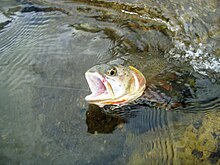The cutbow (Oncorhynchus clarkii × mykiss) is an interspecific fertile hybrid between rainbow trout (Oncorhynchus mykiss) and cutthroat trout (O. clarkii). While natural separation of spawning habitat limited hybridization in most native populations of rainbow and cutthroat trout, introduction of non-native hatchery-raised rainbow trout into native cutthroat trout range increased hybridization across the landscape. Due to these introductions, many populations of cutthroat trout are at risk of genetic pollution. As a result, significant management intervention at state and federal levels has occurred to preserve native populations of cutthroat trout.[1][2]
| Cutbow | |
|---|---|

| |
| Scientific classification | |
| Domain: | Eukaryota |
| Kingdom: | Animalia |
| Phylum: | Chordata |
| Class: | Actinopterygii |
| Order: | Salmoniformes |
| Family: | Salmonidae |
| Subfamily: | Salmoninae |
| Genus: | Oncorhynchus |
| Species: | |
History
editCutbow can occur naturally (albeit irregularly) where the native ranges of both parent species overlap, such as between coastal rainbow trout (O. mykiss irideus) and coastal cutthroat trout (O. clarkii clarkii) and between Columbia River redband trout (O. mykiss gardineri) and westslope cutthroat trout (O. clarkii lewisi).[3]. However, early stocking of rainbow trout in watersheds that contained native cutthroat trout throughout the 19th and 20th centuries increased the occurrence of cutbow in North America.[4] Increased hybridization imperiled or extirpated many populations of cutthroat trout, and hybridization was recognized as problematic by early North American ichthyologists and fishery scientists.[5][6][7]
Description
editLike most fish hybrids, cutbow are difficult to identify based on external characteristics alone.[8] This is further complicated by phenotypic variation of cutthroat trout across their range.[3] Subsequently, many anglers confuse cutbow with rainbow or cutthroat trout. Cutbow have reddish or orange slash markings under the jaw like cutthroat trout. Though most cutbow have dots on their bodies, patterns vary between each fish.
Reproduction
editCutbows are created when the female cutthroat trout's eggs are fertilized by a bigger male rainbow trout[citation needed]. Cutbows spawn during spring and prefer temperatures between 40 and 50°F. They are able to reproduce in natural habitats and in hatcheries. They are almost immune to whirling disease, which affects most trout in Colorado.
References
edit- ^ Mallet and Thurow (2021). "Resurrecting an Idaho Icon: How Research and Management Reversed Declines of Native Westslope Cutthroat Trout". Fisheries. 47: 104–117.
- ^ Al-Chokhachy; et al. (2019). "Return of a Giant: Coordinated Conservation Leads to the First Wild Reproduction of Lahontan Cutthroat Trout in the Truckee River in Nearly a Century". Fisheries. 45: 63–73.
- ^ a b Behnke, Robert J. (2002). Trout and Salmon of North America. Tomelleri, Joseph R. (illustrator). New York: The Free Press. ISBN 0-7432-2220-2.
- ^ Halverson, Anders (2011). "The Origins of Rainbow Trout Stocking - From California to Global Waters". An Entirely Synthetic Fish: How Rainbow Trout Beguiled America and Overran the World. New Haven: Yale University Press. ISBN 9780300140880.
- ^ Miller (1950). "Notes on the Cutthroat and Rainbow Trouts with the Description of a New Species from the Gila River, New Mexico". Occasional Papers of the Museum of Zoology. 529: 1–46.
- ^ Cope (1957). "Races of Cutthroat Trout in Yellowstone Lake". U.S. Fish and Wildlife Service Special Scientific Report - Fisheries. 208: 74–84.
- ^ Behnke (1979). "The Native Trouts of the Genus Salmo of Western North America". Report to US Fish and Wildlife Service: 1–163.
- ^ Rourke and Wallace (1978). "A morphological and electrophoretic comparison of Henry's Lake Salmo clarki and Salmo clarki x Salmo gairdneri hybrids". Comparative Biochemistry and Physiology Part B: Comparative Biochemistry. 60: 447–451.
External links
edit- https://nas.er.usgs.gov/queries/factsheet.aspx?SpeciesID=904
- http://docs.streamnetlibrary.org/CoastalCutthroatData/sn600255.pdf
- https://web.archive.org/web/20100529221503/http://www.isu.edu/~keelerne/cuttpage/SFSR.htm
- https://web.archive.org/web/20101128091813/https://research.idfg.idaho.gov/Fisheries%20Research%20Reports/Res-Rohrer1986%20Evaluation%20of%20Two%20Hybrid%20Trout%20Strains%20in%20Henrys%20Lake%20and%20Comments%20on%20Potential%20Use%20of%20Sterile%20Triploid.pdf
- https://web.archive.org/web/20120824201959/http://wildlife.state.co.us/SiteCollectionDocuments/DOW/Fishing/FisheryWaterSummaries/Summaries/Northeast/ClearCreek.pdf
- https://web.archive.org/web/20120329134649/http://wildlife.state.co.us/SiteCollectionDocuments/DOW/Fishing/FisheryWaterSummaries/Summaries/Northeast/PrewittReservoir_2011_MB.pdf